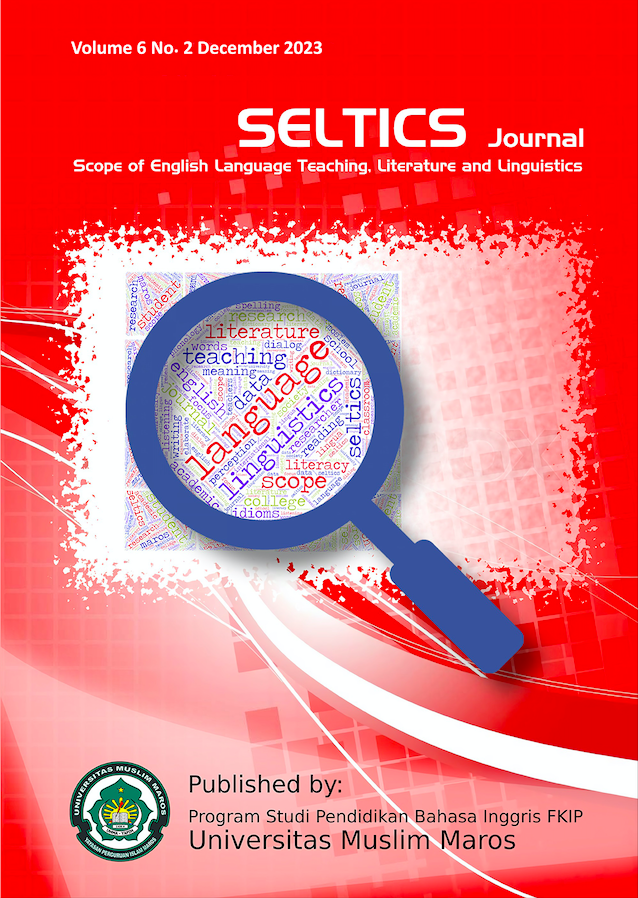Measuring English Proficiency: Investigating How Teachers Employ Formative Tests
DOI:
https://doi.org/10.46918/seltics.v6i2.2061Keywords:
Measuring, English Proficiency,, Formative TestsAbstract
Education holds a crucial role in human life, connecting the roles of teachers and students in teaching and evaluation. Assessment, a big part of education, helps teachers understand how well students are doing as they learn. When assessing students, teachers must consider how each student learns, what they're good at, what they find challenging, and what they need to succeed in school. So, teachers must know how to do assessments well. This study aims to determine the teacher's understanding of formative assessment and how to apply formative assessment to learning English in assessing students' English skills. The method used is a descriptive qualitative method using interviews and observations. 7 English teachers from different schools were interviewed (4 teachers at SMAN 3 Maros, 1 teacher at MA Darussalam Barandasi, and 2 English teachers at SMKN 1 Maros). Meanwhile, observations were carried out once at each school. The findings show that teachers use formative assessment at the beginning, middle, and end of learning sessions to understand students' performance. Teachers see many benefits in using formative assessments, like measuring individual abilities, reaching learning goals, and understanding student needs better. Some teachers face challenges, like figuring out how each student is different, which shows they might need more help and training. Classroom observations also show that some schools do well with formative assessments, while others have problems, such as SMK 1 Maros, which has issues with students not showing up and using home-based assignments. This study suggests giving teachers more support and training to improve assessments and learning for everyone.
References
Andrade, H. L., & Heritage, M. (2017). Using formative assessment to enhance learning, achievement, and academic self-regulation. Routledge.
Aouine, A. (2011). English Language Assessment in the Algerian Middle and Secondary Schools: A Context Evaluation Mouloud MAMMERI University of Tizi-Ouzou Faculty of Letters and Humanities].
Arikunto, S. (2005). Fundamentals of the evaluation of education. Revised edition. The fifth ipression. Jakarta: the literacy of the earth.
Aswar, M. (2018). The effectiveness of formative assessment in evaluating students’ speaking ability Thesis. Muhammadiyah University of Makassar. https://digilibadmin. unismuh …].
Black, P., & McMillan, J. (2012). Formative and summative aspects of assessment: Theoretical and research foundations in the context of pedagogy. Sage handbook of research on classroom assessment, 167-178.
Black, P. J. (1993). Formative and summative assessment by teachers.
Brown, H. D., & Abeywickrama, P. (2004). Language assessment. Principles and Classroom Practices. White Plains, NY: Pearson Education.
Carlton, D. J., Kicklighter, J. R., Jonnalagadda, S. S., & Shoffner, M. B. (2000). Design, development, and formative evaluation of “Put Nutrition Into Practice” a multimedia nutrition education program for adults. Journal of the American Dietetic Association, 100(5), 555-563.
Chism, N. V. N., Douglas, E., & Hilson, W. (2008). Qualitative research basics: A guide for engineering educators. Rigorous Research in Engineering Education, 1-65.
Clark, I. (2012). Formative assessment: Assessment is for self-regulated learning. Educational psychology review, 24, 205-249.
Fitriani, D., Loeneto, B. A., & Inderawati, R. (2021). Formative assessment in English learning of junior high school. English Review: Journal of English Education, 9(2), 463-474.
Hall, K., & Burke, W. (2004). Making formative assessment work: Effective practice in the primary classroom. McGraw-Hill Education (UK).
Hancock, B., Ockleford, E., & Windridge, K. (2001). An introduction to qualitative research. Trent focus group London.
Heritage, M. (2007). Formative assessment: What do teachers need to know and do? Phi Delta Kappan, 89(2), 140-145.
Holmes, N. (2018). Engaging with assessment: Increasing student engagement through continuous assessment. Active Learning in Higher Education, 19(1), 23-34.
Khairil, L. F., & Mokshein, S. E. (2018). 21st century assessment: online assessment. International Journal of Academic Research in Business and Social Sciences, 8(1), 659-672.
Miles, M. B., & Huberman, A. M. (1994). Qualitative data analysis: An expanded sourcebook. sage.
Moss, C. M., & Brookhart, S. M. (2019). Advancing formative assessment in every classroom: A guide for instructional leaders. ASCD.
Munson, C. E. (2010). Assessment of the efficacy of blended learning in an introductory pharmacy class. University of Kansas.
Ojugo, A. (2013). Effect of Formative Test and Attitudinal Types on Student’s Achievement in Mathematics in Nigeria: African Educational Research Journal.
Ozan, C., & Kincal, R. (2018). The effects of formative assessment on academic achievement, attitudes toward the lesson, and self-regulation skills. Educational Sciences-Theory & Practice, 18.
Purwanto, M. N. (2019). Prinsip-Prinsip Dan Teknik Evaluasi Pengajaran.
Richards, J. C., & Schmidt, R. W. (2013). Longman dictionary of language teaching and applied linguistics. Routledge.
Siedlecki, S. L. (2020). Understanding descriptive research designs and methods. Clinical Nurse Specialist, 34(1), 8-12.










